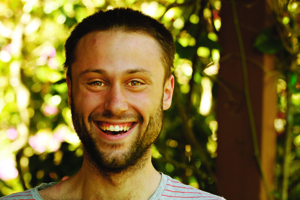The idea began to grow as Nick Lounsbury walked the halls of UC Santa Cruz's Science Hill two years ago.
Posters tacked on walls touted scientific discoveries. Behind the closed doors of labs, researchers were doing innovative work: creating exoskeletons to help stroke victims recover mobility and studying what happens in our brains when we learn new things, for instance.
"I started to connect some dots," says Lounsbury, a 22-year-old neuroscience and mathematics major and Cowell College student who will graduate June 14. "I thought: There is cutting-edge research going on right in our backyard and no one knows about it."
Lounsbury's answer? The creation of UC Santa Cruz's first student-run scientific magazine: Scientific Slug.
Sitting in a wooden Adirondack chair amid the plants and vines that fill Thimann Labs' rooftop greenhouse and nursery, Lounsbury is thoughtful as he describes his years of discovery and exploration at UCSC: potlucks where philosophy and ideas were the main course, gatherings where students and faculty shared thoughts on wide-ranging topics, and late-night discussions on life and existence.
It was in this environment that Lounsbury, the son of two psychotherapists and a self-described "big-picture guy," began delving into neuroscience and math.
He found himself attending sessions of a student-led club called Brain, Mind and Consciousness and becoming so passionate about mathematics he would spend some Saturday nights just solving problems. He volunteered at one of UCSC's research labs.
Into that heady mix came the thought that science's innovative ideas needed to be shared.
"I'd never written a science-based article, but I knew how to read and write, and if you asked me to explain something I could do it," Lounsbury says. "The fact is, it (the magazine) needed to happen."
He recruited students from disciplines as varied as art and engineering. He met with UCSC's Science Communication Program Director Rob Irion.
"I'm so impressed by Nick's initiative and passion," Irion says. "Many undergraduates have talked with me about major projects like this, but Nick is the only one who followed through."
While Lounsbury was listed as the magazine editor, the publication was collaborative, he says. Students brought ideas, began research, submitted artwork. Page templates were created, stories were edited, and an introduction to the magazine was crafted.
"Our values were to communicate science, provide an alternative means of education, and connect students to researchers," Lounsbury says of the magazine. "It was about nerding out on science."
Scientific Slug's first edition included stories on why native tree squirrels were becoming scarce on campus, an exploration of Professor Daniel Friedman's work on conspicuous consumption, and a look at Associate Professor of Physics Stefano Profumo's investigation of WIMPs (Weakly Interacting Massive Particles).
Art ranged from a geometric explosion of brilliantly hued colors to a comic-book-style illustration of how microbes contribute to arsenic contamination of drinking water.
So far, there have only been two editions and funding only allowed the printing of 350 copies, but the impact of the magazine was more profound.
"The new magazine has catalyzed a group of young writers on campus, many of whom hope to make communicating about science part of their career," Irion says. "It also sparks excitement about research at UCSC and gives students ideas about how to get involved."
For his part, Lounsbury is pleased to know that a new crop of writers will continue the magazine next year.
"I will be perfectly content and thrilled if, when I come back to campus in the future, there will still be a group of people who want to talk about science," says Lounsbury, who hopes to work in big data, neuroscience, or statistics research someday. "Whether it (Scientific Slug) is still a magazine or it's a movie or whatever, as long as students are doing that, I'll be perfectly happy."



